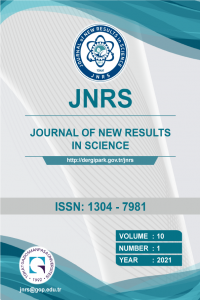Determination of the Optimum Drying Method in Terms of Color Value of Cress (Lepidium sativum L.) Leaves Dried by Microwave Method with Pre-treatment and without Pre-treatment
Garden cress is from Cruciferae family and its origin is Asia. Garden cress, which has a sharp smell, is consumed in fresh and dried form. In addition, there are many benefits in terms of health such as prevention of fat accumulation in body, diuretic, appetite opening. In the study, the average of 5 color values calculated using the primary color values repeatedly measured in 8 different drying conditions were determined and the optimum drying condition was determined according to the fresh product. Drying operations were carried out at 720, 540 360, 180 W power values with or without pre-application. Chroma (C), redness index (b / a), hue angle (h °), total color change (ΔE) and browning index values were calculated by measuring the primary color values of L, a and b after fresh and after drying. The calculated values for the fresh product are 11.90, -1.43, -54.99, -, 13.07, respectively. Drying methods include 360 W power without preheating, 360 W power with pre-applied value in terms of hue angle value, 180 W power value with pre-applied in terms of total color change and browning index In terms of value, the drying conditions of 360 W power without preliminary application determined drying conditions which are most suitable for the determined color values.
Keywords:
microwave drying, pretreatment color values, cress,
___
- Ahmed, S. and Beigh, S.H., 2009. Ascorbic acid, Carotenoids, Total Phenolic content and Antioxidant activity of various genotypes of Brassica Oleracea encephala. J Med Biol Sci, 3: 1-8.
- Aydın, M., 2011. Examination of some enzymatic activities in lepidium sativum (Lepidium sativum) which are interacted with metal. High undergraduate thesis, Sakarya University Graduate School of Natural and Applied Sciences, Sakarya.
- Babalık, Ö. and Pazır, F., 1997. Application of Sulfur Dioxide in Tomato Drying. Food, 22(3): 193-199.
- Çakır, M.T., 2015. Drying of Agricultural Products Utilizing Solar Energy. Journal of Gazi Engineering Sciences, 1(1), 41-56.
- Díaz, G.R, Martínez, M.J., Fito, P. and Chiralt, A., 2003. Modelling of dehydration–rehydration of orange slices in combined microwave/air drying. Innov. Food Sci. Emerg. Technol. 4(2): 203-209.
- Kamel, S.M., 2013. Effect of microwave treaments on some bioactive compounds of parsley (Petroselinum Crispum) and dill (Anethum Graveolens) leaves. Food Processin and Technology, 4:6 http://dx.doi.org/10.4172/2157-7110.1000233.
- Kendir, G. and Güvenç, A., 2010. An overview of ethnobotanic and ethnobotanical studies in Turkey. Journal of Hacettepe University Faculty of Pharmacy, 30(1), 49-80.
- McGuire, R.G., 1992. Reporting of objective color measurements. Hort Science, 27, 1254 - 1255.
- Plou, E., Lopez-Malo, A., Barbosa-Canovas, G.V., Welti-Chanes, J. and Swanson, B.G., 1999. Polyphenoloxidase activitiy and color of blanced and high hydrostatic pressure treated banana puree. Journal of Food Science, 64, 42-45.
- Pisalkar, P. S., Jain, N. K. and Jain, S. K., 2011. Osmo-air drying of aloe vera gel cubes. Journal of food scıence and technology-mysore 48-2, 183-189.
- Polatci, H. and Tarhan, S., 2009. The Effect of Different Drying Methods on Drying and Quality of Reyhan (Ocimum Basilicum) Plant. GOI. Journal of Agricultural Faculty, 26 (1), 61-70.
- Schiffmann, R.F., 2001. Microwave Processes for the Food Industry. In Datta AK, Anantheswaran RC (Eds.), Handbook of Microwave Technology for Food Application (pp. 299-338). New York, Marcel Dekker.
- Sumnu, G., 2001. A review on microwave baking of foods. Int. J. Food Sci. Technol., 36: 117-127.
- Tüik, 2016. http://www.tuik.gov.tr/PreTablo.do?alt_id=1001 (Axcess date: 01.09.2017).
- Wu, T. and Mao, L.C., 2008. Influences of hot air drying and microwave drying on nutritional and odorous properties of grass carp (Ctenopharyngodon idellus) fillets. Food Chem., 110: 647–653.
- Yağcıoglu, A., 1999. Agricultural Product Drying Technique. Ege University Faculty of Agriculture Publications No: 536. Bornova, Izmir.
- Zhou, C., Li, X., Xu, C. and Chen, K., 2011. Effects of drying methods on the bioactive components in loquat (Eriobotrya japonica Lindl.) flowers. Journal of Medicinal Plants Research Vol. 5(14), pp. 3037-3041.
- ISSN: 1304-7981
- Yayın Aralığı: 3
- Başlangıç: 2012
- Yayıncı: TOKAT GAZİOSMANPAŞA ÜNİVERSİTESİ
